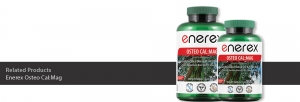

Osteoporosis, calcium confusion and beyond
What is osteoporosis? Your body’s 206 bones are living, ever-changing tissue. Throughout life, your body continuously creates new bone while breaking down and absorbing the old. Your entire skeleton will be replaced every 7 to 20 years (estimates vary), and bone density and strength peak at age 30. But poor nutrition, acidity, lack of exercise and sunshine, low parathyroid hormone and stress cause loss of Calcium and other minerals from bones. This starts to create tiny pits and holes that make them less dense, weak and brittle. This is osteoporosis.
A youthful, vibrant body, at any age, must have a strong structural foundation — meaning your skeleton. You may not give much thought to how healthy your bones are unless you break one. But, one in four women and one in eight men over the age of 50 has osteoporosis, and there are no symptoms… other than broken bones. Will you get it? In Canada, more women die each year as a result of osteoporotic fractures than from breast and ovarian cancer combined. Thousands of fractures happen annually in women 45 or older, and 70 percent are osteoporotic. Between 45 and 75 years of age, women lose 30 percent of their skeletal structure and men lose 15 percent — postmenopausal women lose up to 2 percent of bone per year; men lose .7 percent. The impact is magnified during and after menopause for women because loss of estrogen reduces your body’s ability to regulate the cells which break down bone.
Calcium Confusion
Traditionally, doctors advised getting more Calcium from dairy foods to prevent osteoporosis, but research is proving that this is not the best way to build bones. Your body needs Calcium — it’s used to contract and expand your muscles and blood vessels, to secrete essential hormones and enzymes, and to send messages through your nervous system. It’s so important that without enough Calcium from your diet, your body robs what it needs from your bones. But the type or form that you get it in is crucial.
You are not what you eat; you are what you absorb. Part of the osteoporosis problem is Calcium absorption. It has been estimated that children absorb 75 percent of the Calcium they eat, and adults only absorb about 30 percent — adults’ digestive systems aren’t as efficient as we age. And whereas the Calcium in plant foods is ideal, dairy foods (milk, yogurt, cheese, ice cream) may actually work against the Calcium equation because its acidity might pull Calcium from bones to buffer it. Most Calcium or Calcium/Magnesium supplements are also poorly absorbed so provide minimal benefit.
Beyond Calcium
Moving beyond Calcium Scientists that have tried to find out how to get Calcium into your bones have come to the realization that Calcium can’t do the work on its own. Calcium needs co-workers, called co-factors. Along with Calcium, your body must have enough Magnesium, Vitamin D, Vitamin K, and several trace minerals including Silicon and Boron. The mineral Boron, for example, helps to prevent loss of Calcium and Magnesium (excreted in the urine), and Silicon helps Calcium to be absorbed by the body. Therefore, an effective osteoporosis prevention strategy must include these proven co-factors to maintain bone mineral density and mass. Calcium absorption depends on many variables including the type of Calcium used. Poorly absorbed Calcium carbonate (made from dolomite, shells or coral) acts mainly as an antacid – and is used in indigestion aids – but provides very little Calcium to the bones. Calcium absorption also depends on your age, the amount of protein in your diet, and whether your body gets enough co-factors mentioned. Enerex OSTEO CAL:MAG is scientifically designed to provide the most advanced form of Calcium-Magnesium in perfect balance and with the important booster nutrients so your body absorbs as much as possible. It’s good to the bone! Visit https://enerex.ca/products/osteo-cal-mag.
By Carol Crenna, National Nutritionist, Certified Holistic Nutritionist
Carol Crenna has been a lifestyle and celebrity-profile journalist for 30 years for publications across Canada and the US. She has been a certified nutritionist for 11 years and is currently teaches six-week and two-day healthy weight loss courses in Vancouver.

